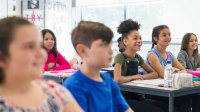Simple Ways to Promote Exploration in Middle School
English language arts teachers can foster moments of joy in the classroom to boost students’ engagement and learning.
Your content has been saved!
Go to My Saved Content.Facing the pressures of the current reality in the classroom can sometimes make teachers feel that they must rush through their curriculum at a rapid pace to make up for lost learning time over the course of the pandemic. Stressful teaching situations, however, can make planning joyful, exploratory learning experiences for students a challenge for teachers.
In reading Zaretta Hammond’s Culturally Responsive Teaching and the Brain, I was struck by the science behind the benefits of allowing students to experience joy and exploration in their learning. In chapter 3, Hammond explains how the brain is a social organ and emotions have a physical component. As the brain experiences joy, the stress hormones that make learning impossible diminish, and new neural pathways are able to form and strengthen.
In short, when students are happy, they learn more. Here are some simple ways ELA teachers might incorporate more joy and exploration with students in the middle grades to increase their learning capacity.
Give Students Time to Explore, Experiment, and Make Mistakes
Teachers do so much to set the tone in their classrooms. Explicitly giving students permission to explore and find joy in their work can be a norm that teachers set from the beginning. In these time-poor days of teaching and learning where everything feels like it was due yesterday, it’s critical to shield students from those feelings of the pressure to rush. Students need time to think and ruminate on ideas, formulate questions, and analyze arguments from multiple perspectives if true, deeper learning is going to take hold.
Giving students time for freewriting is one way middle-grades ELA teachers can give students an opportunity to explore different topics, text structures, writing styles, or writing purposes in deep and meaningful ways. Students ought to be able to take some time to write about any topic they wish without the fear of graded evaluations. This can also give teachers insight into the nuances of their students’ varied learning needs and help set authentic, differentiated writing goals with their students.
Time for freewriting also helps students build stamina, especially after so few had authentic writing experiences during the pandemic. It can be powerful to take a piece of their choosing all the way through the writing process from pre-writing to publishing. Students won’t see themselves as real writers without these opportunities or if their writing purpose is always an academic extended response question.
Just as students deserve time to develop as writers, they also can benefit from time to explore as readers of a wide variety of books. Giving students time to read for joy is one way ELA teachers can help their students develop a lifelong love of learning. The pandemic increased our access to devices, and we can use these same devices to broaden our access to a rich variety of reading materials to engage any learner. For a non-tech approach, teachers can create bingo boards with various genres or types of reading material to encourage student exploration.
If we prioritize student choice, interest, and curiosity, and are careful not to limit what kids might be allowed to read based on perceived reading levels, we will note a change in how our classrooms feel. Shifting our rooms from pressure cookers to places of joy and exploration in reading can be transformative for student learning.
Celebrate Thinking Over Correctness
Traditional ELA classrooms may have once taught grammar as a set of right or wrong rules in isolation. ELA teachers who wish to cultivate joyful exploration in their classrooms can instead affirm students who speak a variety of English grammars and allow all kids to explore the brilliant ways that real authors play with diction, structure, and syntax.
Jeff Anderson’s Mechanically Inclined and Everyday Editing have great lesson ideas about how to use mentor texts with rich, meaningful language that give students plenty to think about and discuss. Teachers might use these texts to inspire students to try the authors’ various techniques intentionally in their own writing.
Joyful, exploratory ELA classrooms will encourage students to build community, develop meaningful relationships, create cross-curricular connections, and learn how to read, write, and think without even realizing that they’re working. The joy that comes from exploratory learning will create happier, more engaged middle-grades students and ultimately happier, more engaged ELA teachers.
